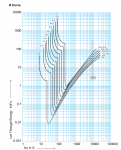PE (always learning)
Senior Member
- Location
- Saint Louis
- Occupation
- Professional Engineer
Hey everyone,
I have a question concerning the ampacity of a conductor not corresponding with the standard ampere rating of the circuit breaker protecting it. The project in question has an 80A transfer switch being fed by (4)#6 THWN and the breakers supplying the transfer switch on both emergency and normal are rated for 70 amps. These breakers are 70A FXD6 Siemens breakers and when they are plotted on SKM with the #6 cable it shows the cable damage curve crossing into the breaker curve. I am considering telling them to beef up the cable size to a #4, but technically the #6 would be acceptable according to NEC 240.4 (B) which allows you to round up when the ampacity of the conductor does not correspond with the standard ampere rating of a circuit breaker. A #6 THWN is good for 65A which is technically allowed to round up to 70A. Should I still tell them to beef up the cable because the breaker curve and cable damage curve are crossing? This would normally not be an issue, but the cable has already been put in place and I've been asked to evaluate the project. Pictures attached for reference.
I have a question concerning the ampacity of a conductor not corresponding with the standard ampere rating of the circuit breaker protecting it. The project in question has an 80A transfer switch being fed by (4)#6 THWN and the breakers supplying the transfer switch on both emergency and normal are rated for 70 amps. These breakers are 70A FXD6 Siemens breakers and when they are plotted on SKM with the #6 cable it shows the cable damage curve crossing into the breaker curve. I am considering telling them to beef up the cable size to a #4, but technically the #6 would be acceptable according to NEC 240.4 (B) which allows you to round up when the ampacity of the conductor does not correspond with the standard ampere rating of a circuit breaker. A #6 THWN is good for 65A which is technically allowed to round up to 70A. Should I still tell them to beef up the cable because the breaker curve and cable damage curve are crossing? This would normally not be an issue, but the cable has already been put in place and I've been asked to evaluate the project. Pictures attached for reference.



